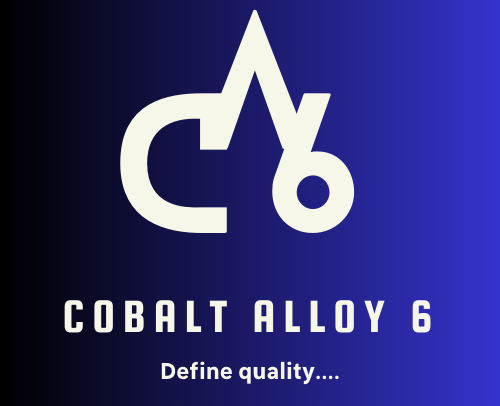Cobalt alloy 6, also known as Cobalt 6B, is used in many industries and applications, including:
- Aerospace and oil/gas: Cobalt 6 is commonly used in the aerospace and oil/gas industries for castings such as pumps, valves, and nozzles.
- Food processing: Cobalt 6B is used in food processing for industrial scraper blades and knives.
- Wastewater treatment: Cobalt 6B is used in wastewater treatment for industrial scraper blades and knives.
- Military: Cobalt 6B is used in the military.
- Power industry: Cobalt 6B is used in the power industry for turbine blade components and bearing assemblies in heat treat furnaces.
- Chemical processing: Cobalt 6B is used in chemical processing for valves.
Cobalt alloy 6 is a cobalt-chromium and tungsten alloy with a Rockwell Hardness Value of 42 HRC. It has excellent wear and oxidation resistance, a low coefficient of friction, and can withstand high heat temperatures of over 1000°F (540°C).
Typical applications include chain saw guide blades, furnace fan blades, high temperature bearings, valve stems, food processing equipment and steel mill equipment.
Cobalt 6 alloys are used in a variety of parts, including:
- Valves: Cobalt 6 alloys are used in valves for steam engines, chemical processing, and power plants
- Bearings: Cobalt 6 alloys are used in bearings for heat treat furnaces
- Knives: Cobalt 6 alloys are used in industrial knives and scraper blades for food processing, waste water treatment, and textiles
- Nozzles: Cobalt 6 alloys are used in nozzles for erosion protection
- Pumps: Cobalt 6 alloys are used in pump plungers and pump shafts
- Chain saw bars: Cobalt 6 alloys are used in chainsaw bars
- Extruder screws: Cobalt 6 alloys are used in extruder screws
- Hot oil pump parts: Cobalt 6 alloys are used in hot oil pump parts
- Hot trimming dies: Cobalt 6 alloys are used in hot trimming dies
- Hot punches: Cobalt 6 alloys are used in hot punches
Few Key Features
- Protection from mechanical and chemical degradation over a wide temperature range
- Saw teeth and acid resistant machine tools.
- Poppet valves, valve seats and gate valves
- Pump shafts, impellers, bearings and rolling couples.
Exceptional Wear Resistance
Cobalt Alloy 6 offers superior performance against wear, galling, and corrosion at high temperatures.
Cobalt Alloy 6 Round Bar
Explore our wear-resistant cobalt alloy 6 round bar collection.
Cobalt alloy 6, also known as Stellite 6, has the following chemical composition:
Chemical Composition
- Cobalt: The balance of the alloy
- Chromium: 27–32%
- Tungsten: 4–6%
- Carbon: 1–2%
- Nickel: 3–4%
- Silicon: 1–2%
- Iron: 3–4%
Here are some mechanical properties of cobalt alloys:
-
Cobalt Alloy 6BHas a tensile strength of 1000 MPa, a yield strength of 621 MPa, an elongation at break of 12%, and a Brinell hardness of 346
-
Stellite 6Has a hardness of 36–45 HRC, a density of 8.44 g/cm, a melting range of 1250–1360°C, and a temperature range where it retains hardness up to 500°C
Cobalt alloy 6, also known as Stellite 6, can be manufactured using a variety of processes, including:
- Direct laser metal deposition: This additive manufacturing process involves the use of laser power and the focal plane position in the powder stream.
- LENS processing: This process can be used to create cobalt-based alloy coatings.
- Forging: This process can be used to create cobalt alloy 6 forgings that are customized to meet specific requirements.
Other processes used to manufacture cobalt alloys include:
- Melting and processing: This process involves melting wrought cobalt alloys in arc furnaces, refining them, and then hot forging and hot rolling them.
- Cold rolling and cold drawing: This process requires many intermediate solution anneals due to the high work hardening rates of cobalt alloys.
- Casting: This is one of the methods used to produce cobalt alloys.
- Powder metal: This is one of the methods used to produce cobalt alloys.
- Hard-faced deposit: This is one of the methods used to produce cobalt alloys.
Cobalt alloys are a group of super-alloys that are made of cobalt and other elements, such as chromium, molybdenum, and nickel. They are known for their high wear resistance and corrosion performance.

